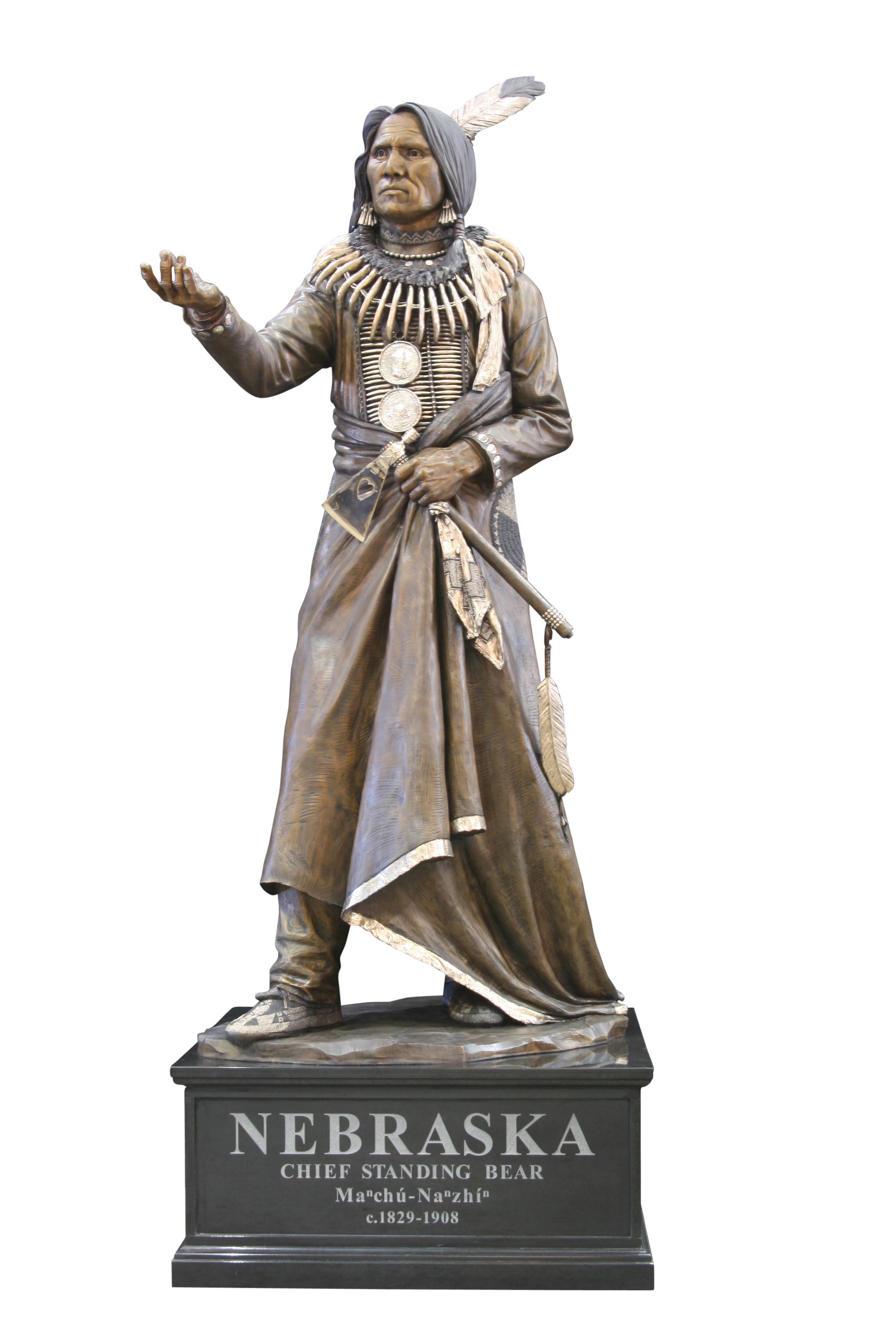
A monumental bronze sculpture honoring Native civil rights icon Ponca Chief Standing Bear will be unveiled in Statuary Hall of the United States Capitol on Wednesday, September 18. The unveiling and dedication ceremony will take place at 3 p.m. EDT in Washington, D.C. A “watch party” of the event will be held in Lincoln, Nebraska in the Warner Chamber of the Nebraska State Capitol at 2 p.m. CDT, the Nebraska Commission on Indian Affairs, and the Nebraska Unicameral’s Special Committee on State-Tribal Relations, with remarks by Nebraska Supreme Court Justice Stephanie F. Stacy.
Each state has an opportunity to select two portrait statues for permanent display in the U. S. Capitol. Nebraska chose statues honoring William Jennings Bryan and J. Sterling Morton, which have been part of the National Statuary Hall collection since 1937. In 2000, Congress enacted legislation inviting states to request replacement of their chosen statues in the collection. The Nebraska Unicameral enacted such a request in 2018 to retrieve the Bryan and Morton portraits for display in Nebraska. In their place, the Unicameral designated statues of author Willa Cather and Ponca Chief Standing Bear. To carry out the placement of the Chief Standing Bear statue, the legislature appointed a committee chaired by Tom Brewer, the Unicameral’s first Native American Senator. Judi gaiashkibos, Executive Director of the Nebraska Commission on Indian Affairs, Kathryn LeBaron, co-chair of Public Art Lincoln, and Ed Zimmer, Lincoln’s historic preservation planner, complete the committee.
Standing Bear v. Crook is a uniquely American episode, in which Standing Bear sued for and won freedom in 1879 from U. S. Army custody for himself and his companions. Not only was the legal case the first time in which an indigenous person spoke before a U. S. Federal Court, it also established that Native Americans were persons, and as such had civil rights. These events had faded from our nation’s consciousness and remained largely untold and untaught until the story experienced a renaissance in recent decades. Books, art, movies and commemoration events relating the story have moved and inspired legal scholars, politicians, citizens and children across the country.
Benjamin Victor of Boise, Idaho is the sculptor of the 9-foot-tall portrait of Chief Standing Bear. He first created the bronze statue in 2017 for outdoor display on Lincoln’s Centennial Mall between the Nebraska State Capitol and the University of Nebraska-Lincoln’s City Campus. A second casting was installed in 2018 at the headquarters in Niobrara, Nebraska of the Ponca Tribe of Nebraska. With the unveiling of the third and final casting in Statuary Hall, Ben Victor will become the only living sculptor to have created three portrait sculptures on permanent display in the U. S. Capitol.
The unveiling ceremony will include remarks by Nebraska Governor Pete Ricketts, members of the Nebraska congressional delegation, other congressional leaders and Nebraska State Senator Tom Brewer. The ceremony will include a Native American color guard, an opening prayer by Ponca Chairman Larry Wright, Jr. and an honor song performed by Steve Laravie, Jr., a direct descendant of Ponca Chief Standing Bear.
Lincoln native Don Campbell was the donor of the statues of Chief Standing Bear for both Lincoln’s Centennial Mall and the U. S. Capitol’s Statuary Hall. He was largely unaware of the story until he learned about it from NCIA Executive Director Judi gaiashkibos in 2015. He was so moved by the story that he decided to commission a world-class bronze to honor the story of the chief and his historic civil rights trial. Benjamin Victor, one of the nation’s leading figurative artists, was identified as the sculptor and was commissioned to create the piece which captures the powerful image of Chief Standing Bear as he stands in a courtroom with his right hand outstretched fighting for the freedom to return to his homeland to bury his son. Standing Bear’s simple, yet powerful declaration of “I Am A Man” would echo through the annals of United States history as one of the defining moments in our nation’s struggles for equality and civil rights.
Judi gaiashkibos, Executive Director of the Nebraska Commission on Indian Affairs, stated “The dedication of this sculpture at the U. S. Capitol is the culmination of my long held dream to honor the story of Standing Bear. His story is symbolic of the struggles and triumphs of so many of the First Peoples of the Great Plains as they fought for their civil rights. I hope that this sculpture will inspire people to learn and to remember these stories and find in their own lives meaning and motivation to honor Standing Bear’s legacy of equality.”